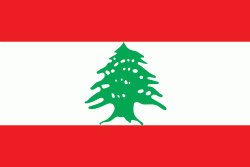Bsharri (Bcharré)
Bsharri (بشرّي Bšarrī; ; also Romanized Becharre, Bcharre, Bsharre, (Bcharre El Arez بشرّي الارز) is a town at an altitude of about 1450 m to 3088 m. It is located in the Bsharri District of the North Governorate in Lebanon. Bsharri is the site of the only remaining original "Cedars of God" (Cedrus libani), and is the birthplace of the famous poet, painter and sculptor Khalil Gibran. A museum in the town honours his life and work.
Bsharri is also home to Lebanon's oldest skiing area, the Cedars Ski Resort, and to the country's first ski lift, built in 1953. The resort is about a two-hour drive and 130 km (81 mi) from Beirut. Qurnat as Sawdā Mountain in Bsharri is the highest peak in the Levant, at 3,088 meters above sea level.
The nearby site of the Holy Kadisha Valley shelters some of the oldest Christian monastic communities in the Middle East. Bsharri, a center of Maronite Christianity, also has the biggest cathedral in the region, the Saint Saba Cathedral, built by Anthony II Peter Arida. Bsharri is sometimes called "the city of churches" as it is home to some 37 churches. The Kadisha Valley and Cedars of God are a UNESCO World Heritage Site.
Maronite Christians fleeing persecution sought refuge in its mountainous terrain in the 7th Century AD. The Kadisha Valley, below the town, became the spiritual center of the Maronite Church. The town was known as Buissera by the Crusades.
Residents of Bsharri are known for their distinct accent when they speak Lebanese Arabic. Unlike other parts of Lebanon, Aramaic was spoken in Bsharri well into the 19th century. As a result, Bsharri natives developed an unmistakably strong accent that lasts to this day.
During the Lebanese civil war, many young men joined the Lebanese Phalanges. In 1986 Samir Geagea, a Bsharri native, became head of the Lebanese Forces (LF) militia (now a political party), and later unsuccessfully ran for president of Lebanon in 2014. Many LF militants were drawn from the town during the civil war.
Bsharri is also home to Lebanon's oldest skiing area, the Cedars Ski Resort, and to the country's first ski lift, built in 1953. The resort is about a two-hour drive and 130 km (81 mi) from Beirut. Qurnat as Sawdā Mountain in Bsharri is the highest peak in the Levant, at 3,088 meters above sea level.
The nearby site of the Holy Kadisha Valley shelters some of the oldest Christian monastic communities in the Middle East. Bsharri, a center of Maronite Christianity, also has the biggest cathedral in the region, the Saint Saba Cathedral, built by Anthony II Peter Arida. Bsharri is sometimes called "the city of churches" as it is home to some 37 churches. The Kadisha Valley and Cedars of God are a UNESCO World Heritage Site.
Maronite Christians fleeing persecution sought refuge in its mountainous terrain in the 7th Century AD. The Kadisha Valley, below the town, became the spiritual center of the Maronite Church. The town was known as Buissera by the Crusades.
Residents of Bsharri are known for their distinct accent when they speak Lebanese Arabic. Unlike other parts of Lebanon, Aramaic was spoken in Bsharri well into the 19th century. As a result, Bsharri natives developed an unmistakably strong accent that lasts to this day.
During the Lebanese civil war, many young men joined the Lebanese Phalanges. In 1986 Samir Geagea, a Bsharri native, became head of the Lebanese Forces (LF) militia (now a political party), and later unsuccessfully ran for president of Lebanon in 2014. Many LF militants were drawn from the town during the civil war.
Map - Bsharri (Bcharré)
Map
Country - Lebanon
 |
 |
| Flag of Lebanon | |
The earliest evidence of civilization in Lebanon dates back to 5,000 BCE. From c. 3200–539 BC, it was home to the flourishing Phoenician civilization before being annexed by various Near Eastern empires. In 64 BC, the Roman Empire conquered the region, and the region became a major center for Christianity under the Byzantine Empire. In the 7th century, the Muslim conquest of the Levant established caliphal rule. The 11th century saw the start of the Crusades and the establishment of Crusader States in the region only for it to be later reclaimed by the Ayyubids and Mamluks before being ceded to the Ottoman Empire in the 16th century. Under Sultan Abdulmejid I, the first Lebanese protostate took form in the 19th century as the Mount Lebanon Mutasarrifate, created as a home for the Maronite Christians under the Tanzimat reforms.
Currency / Language
| ISO | Currency | Symbol | Significant figures |
|---|---|---|---|
| LBP | Lebanese pound | لل | 2 |
| ISO | Language |
|---|---|
| AR | Arabic language |
| HY | Armenian language |
| EN | English language |
| FR | French language |















